Sensor Sweep: Krull, Empire of the Petal Throne, Hero’s Journey, Three-Body Problem
Monday , 5, December 2022 Sensor Sweep Leave a commentCinema (Inverse): In the ‘80s, failed genre films could also come across as sweet and well-meaning (1984’s Supergirl, for example). The best example is also the biggest flop of ‘80s sci-fi flicks: Krull. 39 years ago, Krull hit theaters at a time when no one was ready for it. Tonally, Krull is like an animated Disney film from the 1940s brought to life with actors from the ‘80s.
sweet and well-meaning (1984’s Supergirl, for example). The best example is also the biggest flop of ‘80s sci-fi flicks: Krull. 39 years ago, Krull hit theaters at a time when no one was ready for it. Tonally, Krull is like an animated Disney film from the 1940s brought to life with actors from the ‘80s.
Robert E. Howard (Sprague de Camp Fan): Rather than immediately 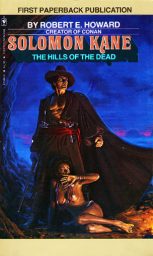 jumping into this story I feel a need to discuss Solomon Kane book publishing first. Of the 16 Solomon Kane adventures (stories and poems) 7 stories were published in Weird Tales. The poem, Solomon Kane’s Homecoming was published in Fanciful Tales. All of the known Solomon Kane stories and poems were first collected in Red Shadows, Donald M. Grant, 1968. This edition was heavily edited and missing “Death’s Black Riders.” There was a second printing in 1971. Then a new second edition in 1978.
jumping into this story I feel a need to discuss Solomon Kane book publishing first. Of the 16 Solomon Kane adventures (stories and poems) 7 stories were published in Weird Tales. The poem, Solomon Kane’s Homecoming was published in Fanciful Tales. All of the known Solomon Kane stories and poems were first collected in Red Shadows, Donald M. Grant, 1968. This edition was heavily edited and missing “Death’s Black Riders.” There was a second printing in 1971. Then a new second edition in 1978.
New (Dark Worlds Quarterly): Here is a very special collection from Trevor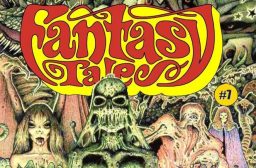 Kennedy and Phantasmagoria Magazine. This book gathers great stories from David A. Sutton and Stephen Jones’ Fantasy Tales from the 1970-90s. You might wonder why I am promoting it since it isn’t a RAGE machine book, but I am in it. And in a way, so is Dark Worlds Quarterly. Trevor approached Steve Dilks about writing a piece on the Sword & Sorcery in Fantasy Tales. He graciously sent Trevor to DWQ.
Kennedy and Phantasmagoria Magazine. This book gathers great stories from David A. Sutton and Stephen Jones’ Fantasy Tales from the 1970-90s. You might wonder why I am promoting it since it isn’t a RAGE machine book, but I am in it. And in a way, so is Dark Worlds Quarterly. Trevor approached Steve Dilks about writing a piece on the Sword & Sorcery in Fantasy Tales. He graciously sent Trevor to DWQ.
 Firearms (Spec Ops Magazine): The MEU (SOC) pistol was specially designed for the Marine Marine expeditionary unit and was officially designated as the M45 MEUSOC. The MEU refers to the Marine expeditionary unit, while SOC refers to special operations capable. It is a variant of the Colt M1911, a standard-issue sidearm for the USMC Force Recon since 1985. The MEU (SOC) pistol is a magazine-fed, recoil-operated, single-action, semiautomatic pistol chambered for the .45 ACP cartridge.
Firearms (Spec Ops Magazine): The MEU (SOC) pistol was specially designed for the Marine Marine expeditionary unit and was officially designated as the M45 MEUSOC. The MEU refers to the Marine expeditionary unit, while SOC refers to special operations capable. It is a variant of the Colt M1911, a standard-issue sidearm for the USMC Force Recon since 1985. The MEU (SOC) pistol is a magazine-fed, recoil-operated, single-action, semiautomatic pistol chambered for the .45 ACP cartridge.
D&D (Walker’s Retreat): I will focus this to the older editions of D&D.
Information has to be found. It is a form of treasure in itself. Therefore, like all other forms of treasure, it must be sought and recovered. Like other forms of treasure, if it has no immediate utility then expect it to be socked away in a vault (literal or otherwise).
Myth (John C. Wright): We were discussing Campbell’s conception that a wheel-shaped pattern called the Hero’s Journey underpins folk tale and myth for all foundational heroic stories, across all cultures and generations. I admit to be deeply unimpressed with Joseph Campbell’s writing, after reading three or four of his books. Allow me to say why. His conceit is that “The Hero’s Journey” begins when some difficulty, a curse or pollution, arises within the safe walls of the home or ordered community where the young hero resides.
Games (Grognardia): Issue #59 of White Dwarf (November 1984), with its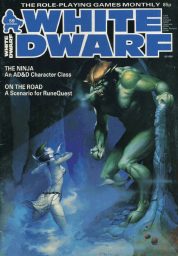 cover by Peter Andrew Jones, is another issue I remember well, since it was published during the run of years when I had a subscription to the magazine. In his editorial, Ian Livingstone notes that the “Fiend Factory” feature, which began all the way back in issue #6 and many of whose entries formed the basis for TSR’s Fiend Folio, would now be presenting new monsters for more RPGs than just Dungeons & Dragons.
cover by Peter Andrew Jones, is another issue I remember well, since it was published during the run of years when I had a subscription to the magazine. In his editorial, Ian Livingstone notes that the “Fiend Factory” feature, which began all the way back in issue #6 and many of whose entries formed the basis for TSR’s Fiend Folio, would now be presenting new monsters for more RPGs than just Dungeons & Dragons.
 Review (With Both Hands): John Straang’s company is back, and everything is even weirder than before. It’s been twenty-five years since the Strange escaped from Crash, or Astralon, call it what you will. They limped away at sublight speeds, hoping for a better tomorrow. It didn’t come.
Review (With Both Hands): John Straang’s company is back, and everything is even weirder than before. It’s been twenty-five years since the Strange escaped from Crash, or Astralon, call it what you will. They limped away at sublight speeds, hoping for a better tomorrow. It didn’t come.
Instead, Sergeant Orion and the rest will go once more into the breach:
Cinema (Kairos): There’s no question about what the best Star Trek movie is. But debate rages over which is the worst. Surprisingly for a long-running Hollywood franchise, a frontrunner for the least enjoyable Star Trek movie also happens to be the series’ first. With that rather inflammatory intro out of the way, It would be sci fi malpractice not to admit that Star Trek: The Motion Picture isn’t a bad film.
movie is. But debate rages over which is the worst. Surprisingly for a long-running Hollywood franchise, a frontrunner for the least enjoyable Star Trek movie also happens to be the series’ first. With that rather inflammatory intro out of the way, It would be sci fi malpractice not to admit that Star Trek: The Motion Picture isn’t a bad film.
 Review (Grim Dark Magazine): The Three-Body Problem by Cixin Liu is the first entry in The Remembrance of Earth’s Past series and has become an international sensation since its original publication in Chinese in 2006 and subsequent English translation by Ken Liu in 2014. The novel opens during the Cultural Revolution, a period of fanaticism where the People’s Republic of China essentially became a personality cult for Mao Zedong.
Review (Grim Dark Magazine): The Three-Body Problem by Cixin Liu is the first entry in The Remembrance of Earth’s Past series and has become an international sensation since its original publication in Chinese in 2006 and subsequent English translation by Ken Liu in 2014. The novel opens during the Cultural Revolution, a period of fanaticism where the People’s Republic of China essentially became a personality cult for Mao Zedong.
Cinema (Monsters & Manuals): I was accused of having spent the last 10 years under a rock yesterday when I texted a friend with the discovery that there is a reboot of Willow in the works. Willow, of all things. I am against ‘reboots’ and remakes as a matter of principle, but even if I wasn’t, I still don’t think I could quite get my head around what it is about Willow that would justify such treatment in its case. When was the last time you even remembered Willow existed, let alone watched it?
Authors (DMR Books): Please introduce yourself and tell us about your 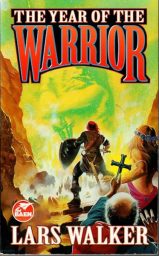 background as a writer. I’m a Minnesota native and live in a Minneapolis suburb. I’m an old man with a checkered past. I’ve been a radio announcer and an academic librarian among other things. Now I’m semi-retired and supplement my income by translating Norwegian movie and TV scripts to English.
background as a writer. I’m a Minnesota native and live in a Minneapolis suburb. I’m an old man with a checkered past. I’ve been a radio announcer and an academic librarian among other things. Now I’m semi-retired and supplement my income by translating Norwegian movie and TV scripts to English.
Awards (REH Foundation): We are pleased to announce the opening of nominations for the 2023 Robert E. Howard Awards starting on November 30, 2022. The Robert E. Howard Foundation has revised the rules and categories for the awards, so please read over the information below.
Culture (Alexander Hellene): There’s a sentiment going around yet again that certain works of art, called “the classics,” which presumably means the Western canon, were not created for people like the non-European individual making this statement. . . The Iliad and The Odyssey were not told or written with Bantu tribesmen or Nordic barbarians in mind. Fyodor Dostoevsky was not writing for Hindu Indians or Muslim Arabs or Anglican Englishmen.
Tolkien (Anna Smol): I’ve just launched a new website designed as a research resource for anyone interested in Tolkien’s alliterative poetry: Tolkien and Alliterative Verse at https://tolkienalliterative.ca. How much alliterative verse did Tolkien write? Check out our Descriptive Bibliography. What is alliterative verse? We’ve got Some Online Guides to Alliterative Metre to illustrate this medieval English style of poetry. What did Tolkien say about alliterative metre? Take a look at a few excerpts in Tolkien’s Notes on Alliterative Metre.
Review (Grim Dark Magazine): The Emperor’s Soul is Brandon Sanderson’s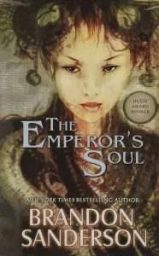 Hugo Award-winning novella inspired by his visit to the National Palace Museum in Taipei, Taiwan. Sanderson was duly impressed by the hundreds of thousands of artifacts on display, covering eight thousand years of Chinese history, and he was particularly drawn to the red stamps used by Chinese artists, scholars, and nobility. Sanderson developed a magic system based on these red stamps, giving them the ability to alter an object’s history, thereby recasting its future. With this, the central idea for The Emperor’s Soul was born.
Hugo Award-winning novella inspired by his visit to the National Palace Museum in Taipei, Taiwan. Sanderson was duly impressed by the hundreds of thousands of artifacts on display, covering eight thousand years of Chinese history, and he was particularly drawn to the red stamps used by Chinese artists, scholars, and nobility. Sanderson developed a magic system based on these red stamps, giving them the ability to alter an object’s history, thereby recasting its future. With this, the central idea for The Emperor’s Soul was born.
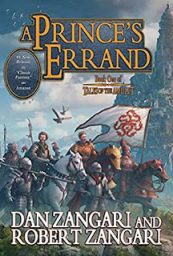 Fantasy (Digital Bibliophilia): This time it’s the turn of the main story in the Legends of Kalda series, Tales of the Amulet. The first book in this series is called A Prince’s Errand, also written by father and son writing partnership of Dan and Robert Zangari. As I said in my previous post, although this novel was published bfore the prequel The Prisoner of Tardalim, I had already decided to read it after that book.
Fantasy (Digital Bibliophilia): This time it’s the turn of the main story in the Legends of Kalda series, Tales of the Amulet. The first book in this series is called A Prince’s Errand, also written by father and son writing partnership of Dan and Robert Zangari. As I said in my previous post, although this novel was published bfore the prequel The Prisoner of Tardalim, I had already decided to read it after that book.
Art (Goodman Games): With scores of novels spanning the popular genres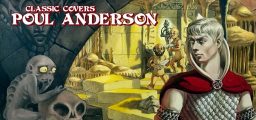 of science fiction and fantasy, with hundreds of magazine and anthology appearances, and with a career spanning the most creative era of visual marketing in publishing of the 20th century, Poul Anderson’s bibliography has the quintessential ‘Classic Covers’ ingredients. Here is but a small sample of the art that brought Anderson’s stories to life.
of science fiction and fantasy, with hundreds of magazine and anthology appearances, and with a career spanning the most creative era of visual marketing in publishing of the 20th century, Poul Anderson’s bibliography has the quintessential ‘Classic Covers’ ingredients. Here is but a small sample of the art that brought Anderson’s stories to life.
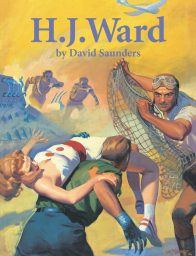 Pulp (Pulp Superfan): When it comes to spicy pulp covers, the artist I think of is H.J. Ward (1909-45). But I was surprised to learn that he actually did a lot more, including work on The Lone Ranger and The Green Hornet. And sadly to realize that had he lived longer, he might have continued his career doing covers for the men’s adventure magazines and maybe into paperbacks.
Pulp (Pulp Superfan): When it comes to spicy pulp covers, the artist I think of is H.J. Ward (1909-45). But I was surprised to learn that he actually did a lot more, including work on The Lone Ranger and The Green Hornet. And sadly to realize that had he lived longer, he might have continued his career doing covers for the men’s adventure magazines and maybe into paperbacks.
Cinema (Neotextcorp): Trying to catch a break from all the Star Wars hype, in the spring of 1977 George Lucas was resting on a Hawaiian beach, building sand castles with his friend and colleague Steven Spielberg, who was also reposing after the making of Close Encounters of the Third Kind. As the two of them were trying to catch their breath, having finished two hugely successful and important films, they started talking about Lucas’ old idea for an action-adventure movie that would echo the Republic serials from the 1930s and 1940s.
Comic Books (Iron Age Media): French roman graphique writer Xavier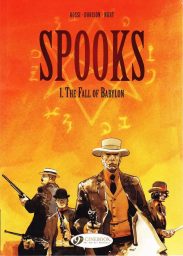 Dorison is best known right now for his ongoing western horror Undertaker series, but if you go back a decade you’ll find his S.P.O.O.K.S. stories were even better. S.P.O.O.K.S. is a paranormal, conspiratorial western espionage action-adventure graphic novel series. Imagine a wild mash-up of “Mission: Impossible” + “The X-Files” + “The Magnificent 7,” set amid real-life historical events just after the American Empire’s turn into the 20th Century.
Dorison is best known right now for his ongoing western horror Undertaker series, but if you go back a decade you’ll find his S.P.O.O.K.S. stories were even better. S.P.O.O.K.S. is a paranormal, conspiratorial western espionage action-adventure graphic novel series. Imagine a wild mash-up of “Mission: Impossible” + “The X-Files” + “The Magnificent 7,” set amid real-life historical events just after the American Empire’s turn into the 20th Century.
History (Last Stand on Zombie Island): Exceedingly well-told by the late 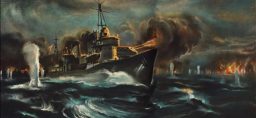 (great) James D. Hornfischer in Neptune’s Inferno, while the land campaign, spearheaded by the “Old Breed” of the 1st Marines then closed out by the follow-on 2nd Marines and the Army/s 23rd and 25th Infantry divisions lasted six months and two days (from the first landings on 7 August 1942 to U.S. Army Major General Alexander Patch realizing on 9 February 1943 that the last intact Japanese force of Gen. Harukichi Hyakutake’s 17th Army withdrew two days prior), the Naval conflict was more compressed. It is generally bookended by seven deepwater sea battles conducted between the nights of 9 August to 30 November 1942– a span of just 113 days.
(great) James D. Hornfischer in Neptune’s Inferno, while the land campaign, spearheaded by the “Old Breed” of the 1st Marines then closed out by the follow-on 2nd Marines and the Army/s 23rd and 25th Infantry divisions lasted six months and two days (from the first landings on 7 August 1942 to U.S. Army Major General Alexander Patch realizing on 9 February 1943 that the last intact Japanese force of Gen. Harukichi Hyakutake’s 17th Army withdrew two days prior), the Naval conflict was more compressed. It is generally bookended by seven deepwater sea battles conducted between the nights of 9 August to 30 November 1942– a span of just 113 days.
Miniatures (Jon Mollison): Just in time for the release of Osprey’s latest hardback, “Xenos Rampant”, comes my new Rebel Miniatures fighting fifteens. This time I remembered to take shots of the primed figures.
hardback, “Xenos Rampant”, comes my new Rebel Miniatures fighting fifteens. This time I remembered to take shots of the primed figures.
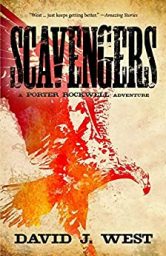 Weird Western (Marzaat): This is the first book in West’s Dark Trails Saga of weird westerns featuring, of course, Porter Rockwell. If you want a western with plenty of lead being slung about, this one’s for you.
Weird Western (Marzaat): This is the first book in West’s Dark Trails Saga of weird westerns featuring, of course, Porter Rockwell. If you want a western with plenty of lead being slung about, this one’s for you.
Uncategorized (Frontier Partisans): Some months ago, I posted on the remarkable tale of Pablo Escobear, the poor critter that ingested 70 pounds of cocaine that was dumped out of a drug runner’s plane near the Georgia-Tennessee line. This you-can’t-make-this-shit-up episode tied together some of my favorite things, to include Waylon Jennings and Justified.
Horror (M Porcius): On Richard Matheson’s isfdb page we see listed a series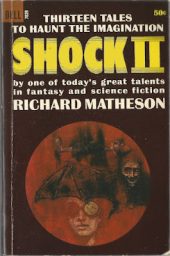 consisting of four collections, each with “shock” in its title. On a recent visit to our nation’s capital, I purchased a copy of the second volume of the Shock series, Shock II, Dell 7829, at Second Story Books on Dupont Circle. Shock II offers “Thirteen Tales to Haunt the Imagination” originally published in the period 1952-62 and we here at MPorcius Fiction Log are going to cover them all, in the order they appear in the book.
consisting of four collections, each with “shock” in its title. On a recent visit to our nation’s capital, I purchased a copy of the second volume of the Shock series, Shock II, Dell 7829, at Second Story Books on Dupont Circle. Shock II offers “Thirteen Tales to Haunt the Imagination” originally published in the period 1952-62 and we here at MPorcius Fiction Log are going to cover them all, in the order they appear in the book.
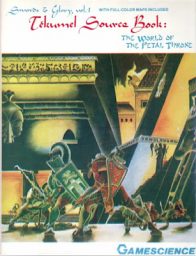 RPG (Grognardia): As early roleplaying game go, Empire of the Petal Throne is fairly well known, if only for the fact that it was the second RPG published by TSR, just about a year and a half after the release of OD&D. EPT is legendary, too, for its price tag – $25 – which was a considerable sum in 1975 (D&D, by contrast, retailed for $10).
RPG (Grognardia): As early roleplaying game go, Empire of the Petal Throne is fairly well known, if only for the fact that it was the second RPG published by TSR, just about a year and a half after the release of OD&D. EPT is legendary, too, for its price tag – $25 – which was a considerable sum in 1975 (D&D, by contrast, retailed for $10).
Reading (Taki Mag): The rise and fall of fame—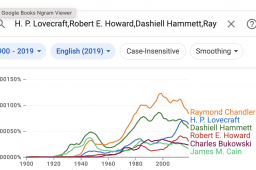 or at least of the number of times books mention the name of an artist or other historical figure—can be conveniently graphed using Google’s free Ngram Viewer. Google has digitized the contents of 129 million books. Ngram lets you look up how relatively frequently a text string comes up out of all the words published in all the books in any year from 1800 to 2019. Among 20th-century American pulp writers, H.P. Lovecraft (The Mountains of Madness) and Robert E. Howard (Conan the Barbarian) have enjoyed good 21st centuries.
or at least of the number of times books mention the name of an artist or other historical figure—can be conveniently graphed using Google’s free Ngram Viewer. Google has digitized the contents of 129 million books. Ngram lets you look up how relatively frequently a text string comes up out of all the words published in all the books in any year from 1800 to 2019. Among 20th-century American pulp writers, H.P. Lovecraft (The Mountains of Madness) and Robert E. Howard (Conan the Barbarian) have enjoyed good 21st centuries.
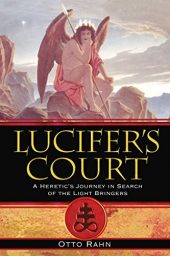 Nazis (With Both Hands): This book and its companion volume,Crusade against the Grail (1), are about as close as we can get to an “authoritative” statement of the esoteric dimension of the Nazi regime in Germany. The publication of the Crusade book in 1933 persuaded SS leader Heinrich Himmler to invite its author, Otto Rahn (1904-1939), to work for the SS as a folklorist.
Nazis (With Both Hands): This book and its companion volume,Crusade against the Grail (1), are about as close as we can get to an “authoritative” statement of the esoteric dimension of the Nazi regime in Germany. The publication of the Crusade book in 1933 persuaded SS leader Heinrich Himmler to invite its author, Otto Rahn (1904-1939), to work for the SS as a folklorist.
Please give us your valuable comment